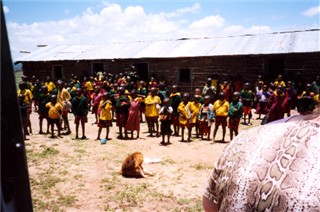 |
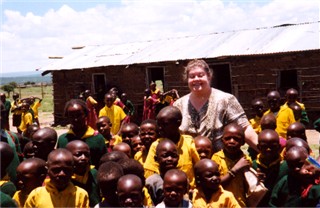 |
We hit the road early this morning for the long drive over extremely bumpy roads to the Masai Mara Game Reserve. For the last thirty miles or so, we were driving on dirt roads. Pepe seemed as good at dodging potholes here as he had been at dodging pedestrians in Nairobi!
Wendy is an elementary school music teacher, and several times during our trip she had said how much she'd like to visit a school. Pepe knew of a Masai school that we'd be passing before we reached the park. He seemed a little reluctant to stop, since no prior arrangements had been made. I must admit that I, too, had reservations about intruding on their school day. But, stop we did, and the kids and their teacher welcomed us so warmly that it turned out to be one of the real highlights of our trip! The kids even sang a couple of songs for us (Wendy was amazed at how good they were at such a young age). Marcia returned the favor by leading them in a call-and-response version of "The Twist" (we were pretty sure they didn't understand the words!) It was truly touching to be reminded how universal children are in their excitement and joy, and yet how different these kids' lives are from our own. We were only there for about 20 minutes, but this stop certainly made a lasting impression on us all.
 |
 |
We continued on our way, and soon passed some animals we hadn't seen before on either side of the road. Pepe said "On the left side of the road are some wildebeest, and on the right are some gnu" (below). Mark asked "What's the difference? I thought they were the same animal." Pepe replied "The difference is, when they are on the left side, I call them wildebeest, and when they are on the right side, I call them gnu. Many years ago, a customer asked me the riddle about the chicken crossing the road, so I have one for you: why did the wildebeest cross the road? To get a gnu name!" Have I mentioned that Pepe had a great sense of humor? He really enriched our whole safari experience. He told us that he usually gave tours to groups from Spain, so he had adopted the nickname Pepe for the sake of his Spanish-speaking customers.
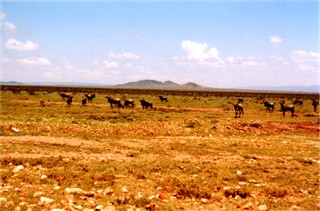
As you can see in the picture, there weren't many wildebeest here. At this time of the year, most of them (several million animals) are on the Serengeti Plains to the south in Tanzania. Their migration northward begins in the summer, and is one of the great spectacles of nature. Pepe said if you came back in August or September, they'd all be in the Mara. We only got to see the few year-round residents that don't migrate.
Shortly before 2pm, we arrived at the Mara Simba Lodge. To me, this was absolutely the best place we stayed. It perfectly fulfilled all my best Adventureland fantasies! Below is the entry gate and the resort's logo from the cardboard coaster I swiped from the room.
 |
 |
Here are a couple of pictures I scanned from their brochure. The aerial photo below shows the main building complex (with the lobby, dining room, bar, and gift shop) next to the swimming pool. The separate building at the very top of the photo is where our room was. There were several of these detached bungalows on either side of the main building, and each one had six or seven rooms. The room Mark and I shared had two beds, but otherwise looked identical to the one shown below.
 |
 |
The whole resort is built on the banks of the Talek River. Below left is a picture I took of the view from our open-air dining room (seen at right). We saw several crocodiles and a lone hippo in the river during our two days here.
 |
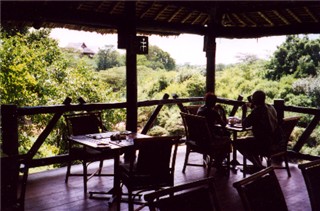 |
After lunch and a rest from the bumpy road, it was time to head out on our first game drive in the Mara. During the first hour, we only saw a few animals like these marabou storks and topi antelope.
 |
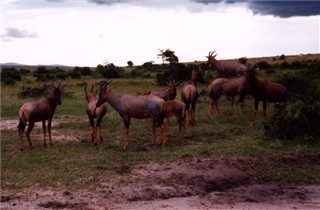 |
An afternoon rain storm was building up, creating a dramatic sky for my two favorite pictures. The lone tree at left is an acacia or umbrella thorn. Pepe said the bird on top of the stump at right is a lilac-breasted roller.
 Click here for a wallpaper-sized version. |
 |
Speaking of the weather, it rained on us every day we were in Kenya, but not enough to keep us from doing anything. People were wondering if this was the start of an early rainy season, which typically begins in April. By the time we left, the consensus seemed to be that it wasn't. The temperatures we experienced were very pleasant. Highs were usually in the upper 70s to mid 80s, with nighttime lows in the mid 60s.
The second hour of our game drive was much more exciting. We came upon a lion lyin' right next to the road! As you can see, he was quite unimpressed with us. It started to rain, so he ambled off for some shelter after about 10 minutes.
 |
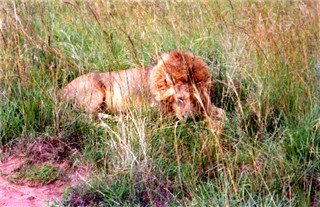 |
Next we found a small herd of elephants. It's so bizarre to see these large creatures running around totally unfettered. Of course, that's how it should be, but it sure makes you aware of how small and crushable your safari van is!

Soon after, we came across another lion. This one was lying right in the road, so we had to off-road around him. Isn't he beautiful? I think he knows it, though -- he sure was posing for us!
 |
 |
Suddenly, there was some excitement over the radio. Pepe and Thomas kept in contact with the other safari vans in the park about the location of the animals. They talked to each other in Swahili, so we weren't sure what was going on. Then Pepe said "The cheetah have just taken down an impala, and it's still alive." We were off in a flash. When we arrived at the scene, you could see that the impala was still breathing as the cats hovered over it. Pepe said it was a mother (in the picture at left, she's second from left) with three cubs. It was both a fascinating and repulsive thing to watch. It was a difficult kill because of the inexperienced cubs, and the impala actually struggled to its feet at one point before being taken back down. If I had seen this on a nature show, I probably would have changed the channel. But there was something very special about seeing the survival story play out right before your eyes.
 |
 |
It had been gently raining for awhile, but as we watched the cheetah it became a downpour. The dirt roads turned into rushing rivers of mud. Several times, I felt the van sliding sideways as we made our way back to the lodge. I was very grateful for both four-wheel-drive, and Pepe's driving skills!
Between the animals (especially the cheetah) and the school visit, today was a day I will never forget. We had only one more day in the Mara before we had to head back home. Tomorrow, we'd be seeing things from a whole new angle....